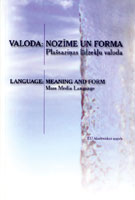Metaforu lietojums presē
The Usage of Metaphors in the Mass Media
Author(s): Dite LiepaSubject(s): Language and Literature Studies, Media studies, Communication studies
Published by: Latvijas Universitātes Akadēmiskais apgāds
Keywords: metaphors; tropics; media; cognitive approach; political discourse;
Summary/Abstract: Mass media language is socially commissioned to confirm or break the existing stereotypes, to create different ones, to dispel socio-political myths by interpreting and evaluating the past from the perspective of the future. Thus, effective means should be selected to affect the addressee emotionally. As various notions in society are predominantly shaped by the mass media, the media make the tropes perform their basic function – to affect the addressee. What is said is of less importance than how it is said. A metaphoricized text is attention attracting, and facilitates its perception on the basis of transference of meaning. Metaphors seem to be the most common and convenient language means used to shape the public opinion, to transform the unknown into the known, the ordinary into the extraordinary in the circumstances of enormous information overload. Moreover, tropes have aesthetic and cognitive effect. The conclusions drawn by G. Lakoff and M. Johnson, the representatives of the cognitive theory of metaphor, in their book “Metaphors We Live By” have been used in the given article. The universal nature of metaphor has been emphasized. Metaphor is not treated merely as a language phenomenon but as a universal semantic, cognitive phenomenon of experience and cognition. In the present article, metaphors are treated as the most common trope used in the traditional press genres: commentaries, interviews, problem articles, reports, and satire. The examples have mainly been selected from 3 daily newspapers: “Diena”, “Neatkarīgā Rīta Avīze” and “Latvijas Avīze”. Moreover, the most striking statements made by politicians, and extracts from the Parliament (Saeima) discussions are also quoted by the above-mentioned daily newspapers.
Journal: Valoda: nozīme un forma
- Issue Year: 2009
- Issue No: 1
- Page Range: 14-24
- Page Count: 11
- Language: Latvian

